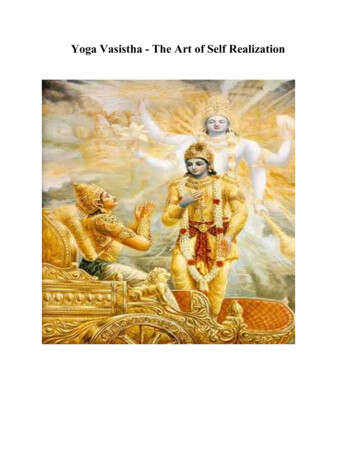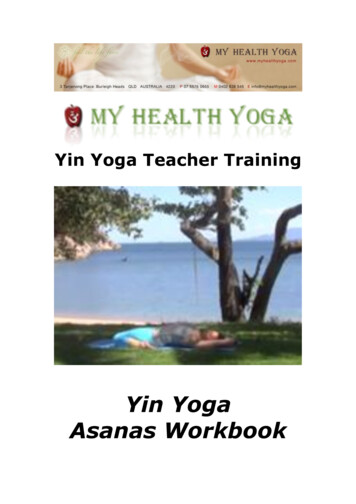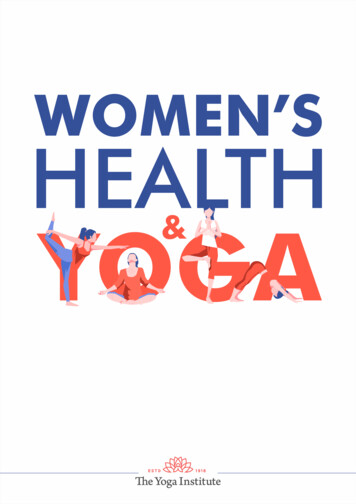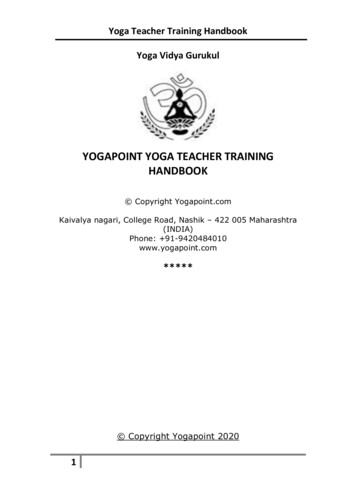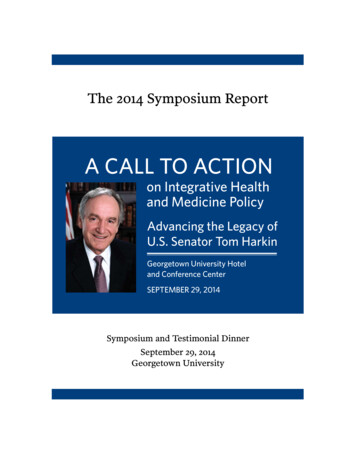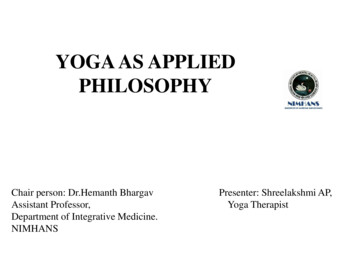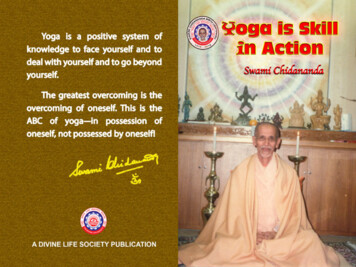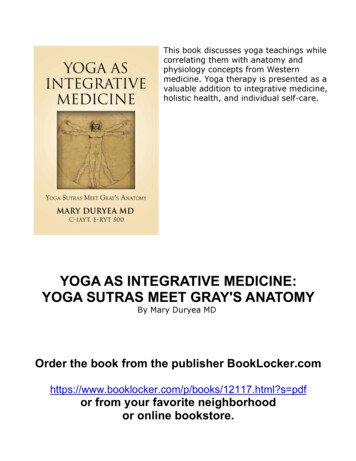
Transcription
This book discusses yoga teachings whilecorrelating them with anatomy andphysiology concepts from Westernmedicine. Yoga therapy is presented as avaluable addition to integrative medicine,holistic health, and individual self-care.YOGA AS INTEGRATIVE MEDICINE:YOGA SUTRAS MEET GRAY'S ANATOMYBy Mary Duryea MDOrder the book from the publisher 2117.html?s pdfor from your favorite neighborhoodor online bookstore.
Copyright 2021 Mary Duryea MD, C-IAYT, E-RYT 500Print ISBN: 978-1-64719-866-4Ebook ISBN: 978-1-64719-867-1All rights reserved. No part of this publication may be reproduced, stored in aretrieval system, or transmitted in any form or by any means, electronic,mechanical, recording or otherwise, without the prior written permission of theauthor.Published by BookLocker.com, Inc., Trenton, Georgia.Printed on acid-free paper.BookLocker.com, Inc.2021First EditionLibrary of Congress Cataloguing in Publication DataDuryea MD, C-IAYT, E-RYT 500, MaryYoga As Integrative Medicine by Mary Duryea MD, C-IAYT, E-RYT 500Library of Congress Control Number: 2021920410
This book represents the author’s personal experiences with and opinions about theteachings of yoga and the ways yoga therapy can be integrated with Westernmedicine, both conceptually and as a practical tool. The content of this book is notintended as medical advice. As with any new activity, consult with your healthcareprovider before practicing any of the tools or techniques discussed in this book. Theauthor, beneficiaries, illustrators, editors, publishers, and distributors assumeno responsibility or liability for any injuries or losses that may result frompracticing yoga or any other exercise program.The author and publisher are providing this book and its contents on an as is basisand make no representations or warranties of any kind with respect to this book or itscontents. The author and publisher disclaim all such representations and warranties,including for example warranties of merchantability and healthcare for a particularpurpose. In addition, the author and publisher do not represent or warrant that theinformation accessible via this book is accurate, complete, or current.The statements made about products and services have not been evaluated by theU.S. Food and Drug Administration. They are not intended to diagnose, treat, cure, orprevent any condition or disease. Please consult with your own physician or healthcarespecialist regarding the suggestions and recommendations made in this book.Except as specifically stated in this book, neither the author or publisher, nor anyauthors, contributors, or other representatives will be liable for damages arising out ofor in connection with the use of this book. This is a comprehensive limitation of liabilitythat applies to all damages of any kind, including (without limitation) compensatory;direct, indirect or consequential damages; loss of data, income or profit; loss of ordamage to property and claims of third parties.You understand that this book is not intended as a substitute for consultation with alicensed healthcare practitioner, such as your physician. Before you begin anyhealthcare program, or change your lifestyle in any way, you will consult your physicianor other licensed healthcare practitioner to ensure that you are in good health and thatthe examples contained in this book will not harm you.This book provides content related to topics physical and/or mental health issues. Assuch, use of this book implies your acceptance of this disclaimer.
TABLE OF CONTENTSChapter One: East Meets West . 1Chapter Two: A Physician’s Perspective on Yoga . 11Chapter Three: Ancient Yoga Teachings and Texts . 25Chapter Four: Ayurvedic Medicine and the Doshas . 41Chapter Five: Yoga Concepts. 67Chapter Six: The Chakras and the Nadis . 85Chapter Seven: Asana . 117Chapter Eight: Pranayama . 137Chapter Nine: Meditation . 147Chapter Ten: Integrating Yoga with Western Medicine . 161Some Favorite Quotes. 187Glossary . 195References . 201vii
Chapter One:East Meets West"We live in succession, in division, in parts, in particles. Meantimewithin man is the soul of the whole; the wise silence; the universalbeauty, to which every part and particle is equally related; the eternalONE." The Over-Soul by Ralph Waldo EmersonAn Invitation to ContemplationYoga has become immensely popular in recent years andgained status around the world. Millions of people stronglyembrace the practice as a form of physical fitness and stressreduction. Images of yoga now permeate our modern society,with media depictions being commonplace compared withtwenty years ago. Numerous studios and teacher trainingprograms have sprung up worldwide. Yoga has beencommercialized through social media, exotic retreats,fashionable clothing, cool mats, and new props. Being widelypracticed around the world, yoga has justifiably earned dualcitizenship, at home both in the East and in the West.Fortunately, the newly emerging field of yoga therapy is alsobecoming an accepted part of Western integrative medicine.Why are so many people embracing yoga and willing tospend time and money on it? Because adopting yoga practicesas lifestyle habits may improve one’s sense of well-being andcontentment, as well as fill a void in self-nurturing that exists formany of us. Often, right from the start, the physical practice ofyoga will initiate a greater sense of health and ease in the body.With continued time, commitment, and a deeper understanding1
Mary Duryea MD, C-IAYT, E-RYT 500of the teachings of yoga, a sense of mental, emotional, andspiritual well-being may also emerge. This ability for an individualto self-nurture through the practice of yoga is likely to improveoverall health and quality of life.Having been around for thousands of years in its variousforms, yoga is clearly here to stay. Yoga appeals to many peoplewith a wide variety of backgrounds. Why is this true? What aresome of its traditional teachings? What are the tools used toachieve a more holistic progression toward improved health?What exactly is being taught and how does it work? What aresome potential cautions related to yoga practices? These aresome of the questions I address in this book through the lens ofmy experience as a Western medicine physician.I want to appeal to healthcare providers who recommendyoga to learn more about it, so yoga becomes less esoteric. Ialso want to appeal to inquisitive yoga teachers who wish tointegrate Western medical concepts into yoga teachings, andperhaps pass this knowledge on to their clients. In parts of thisbook, yogic concepts are correlated with teachings of anatomyand physiology from Western medicine. I have endeavored touse straightforward language so that both the Western medicalterms and the yogic concepts make sense to the general reader.My goal for this book is to help medical professionals betterunderstand yoga, to help the yoga practitioner better understandWestern medicine, and to help everyone appreciate the powerof yoga to enhance the human experience.I also want to advocate for yoga therapy as a key componentof integrative medicine, which combines traditional Westernmedicine with other techniques to improve the overall health of2
Yoga As Integrative Medicinethe individual. The National Institutes of Health (NIH) websitestates:“Integrative healthcare often brings conventional andcomplementary approaches together in a coordinatedway. It emphasizes a holistic, patient-focused approachto healthcare and wellness—often including mental,emotional, functional, spiritual, social, and communityaspects—and treating the whole person rather than, forexample, one organ system. It aims for well-coordinatedcare between different providers and institutions.”iNote that this definition does not involve just physical wellbeing, but also “mental, emotional, functional, spiritual, social,and community aspects.” Yoga addresses each of these aspectsof an individual. I find it particularly gratifying that “spiritual” wasincluded in this NIH definition. Spirituality was originally theprimary focus and most important aspect of yoga. Traditionally,spirituality has not been emphasized in Western medicine. Yogamay help fill this “spirituality gap” in modern medical healthcare.And although yoga addresses this topic, yoga is not a religionand can be practiced by anyone regardless of religious beliefs.I envision yoga therapy as a growing part of integrativemedicine, in which a variety of professionals each bring their ownunique skill set for care of the patient. Integrative medicine israther like a healthcare “stew.” If a variety of high-qualityingredients—that is, qualified healthcare professionals—isincorporated into healthcare, then the final product, namely thehealth of the patient, benefits. Yoga also empowers patients totake an active role in their own self-care. Once learned, yoga canbe practiced by virtually anyone, anywhere, anytime and takeslittle space, time, or money.3
Mary Duryea MD, C-IAYT, E-RYT 500In this informative book, I share my own personal journey oftraining in Western medicine and later learning about yoga.Some concepts from ancient texts and teachings, including theYoga Sutras, are presented. Ayurvedic medicine, which is anEastern style of holistic medicine that has been practiced in Indiafor thousands of years—sometimes called the sister science ofyoga—will also be introduced. The chapter on ayurvedicmedicine discusses the doshas, three groupings of bioenergetictraits that combine to characterize the physical, emotional, andmental characteristics of each individual. The determination ofan individual’s dosha type helps guide ayurvedic physicians andyoga therapists in choosing specific therapies to promote wellbeing.Yogic teachings—including the energy centers (chakras),energy channels (nadis), and layers or aspects of individuals(koshas) —are discussed in the chapters that follow. Techniquesregarding postures (asanas), breathing (pranayama), andmeditation will be presented. The physiology of the autonomicnervous system, which works in the background to control manybody functions, will be linked to various yoga practices. I alsotouch on some recent fascinating scientific studies that havedemonstrated benefits of the practice of yoga and meditation.Case studies at the end of the book are intended to tie everythingtogether as real-life examples of practical use.I recommend that those who are new to these concepts tryto avoid getting caught up in the terminology, and insteadconsider the broader ideas being presented. I place Sanskritwords in italics when introduced, except for some of the morecommon Sanskrit words such as asana (postures) andpranayama (breath). Sometimes, Latin words used in medical4
Yoga As Integrative Medicineterminology or Sanskrit terms found in yoga can be intimidatingwhen unfamiliar. I recommend that you keep reading and try tosee the relationships presented, instead of trying to memorizeunfamiliar terms. Think of this book as a “holistic” read ratherthan a textbook.My hope is that you will find these subjects as fascinating asI do and find that the tools presented are practical for use in yourown daily life. I admit that I was initially skeptical of someconcepts such as the chakras when I first learned about them.But I have gradually merged my worldview and medicalknowledge of anatomy and physiology with the teachings ofyoga. This integration has allowed various concepts to makesense to me now. My hope is that this book will do the same foryou.A Brief HistoryThe ancient practice of yoga, originating approximately 5000years ago in India, started migrating to the Western world in the19th century.ii Ralph Waldo Emerson, who had studiedtranslations of ancient Hindu texts including the Bhagavad Gita,was influential in this migration. He published his essay “Nature”in 1836, which spearheaded the American Transcendentalistmovement. His poem “Brahma” later appeared in the newlyformed Atlantic Monthly in 1857, reflecting his concepts of Hinduspirituality.Emerson heavily influenced Henry David Thoreau, who wasperhaps the first American to consider himself a practicing yogi.Thoreau wrote Walden while living on land owned by Emerson.These two influential Transcendentalists favored individual5
Mary Duryea MD, C-IAYT, E-RYT 500exploration of spirituality, especially utilizing the presence ofnature rather than religious dogma.Perhaps the first person traditionally trained in India tointroduce yoga to the West was Swami Vivekananda, a youngmonk from Kolkata (Calcutta). In 1894 he attended the World’sFair and the Parliament of the World’s Religions in Chicago. Apowerful speaker, he electrified audiences while speaking aboutyoga, Hinduism, and India. He continued on an influential tour ofthe US and published Raja Yoga in 1896, interpreting andtranslating from Sanskrit the teachings from Patanjali’s YogaSutras.Turning now to the history of Western medicine, the classictextbook Gray’s Anatomy was first published in 1858, the workof Dr. Henry Gray and his coworker and illustrator Dr. HenryVandyke Carter. A few years before, the Anatomy Act of 1832had been passed in England. Prior to this, it was illegal to dissectany human bodies except for executed murderers. Now havinglegal access to corpses, these two talented men dedicated manyhours to the cadaver lab. Dr. Carter helped with dissections andproduced the meticulously accurate and beautiful illustrations.The book Gray’s Anatomy was an instant best seller, andsubsequent editions have been used by generations of medicalstudents as an integral part of their training.Dr. Gray unfortunately died from smallpox at the youthful ageof 34. Dr. Carter, who was never given due credit or properfinancial reward for his work on the book, left England to practicemedicine in Mumbai (Bombay) with the Indian Medical Service.Dr. Carter represents an early example of Western and Easternmedicine co-mingling and sharing knowledge, including his6
Yoga As Integrative Medicineprofound expertise in anatomy. After 30 years he returned toEngland and died at the age of 65 from tuberculosis.The fascinating Indra Devi, born in Russia in 1899 andoriginally named Eugenie V. Peterson, was influential inspreading yoga throughout the Western world. When she was ateen, she and her mother fled Russia for Berlin during theBolshevik Revolution. In her twenties she moved to India,changing her name to Indra Devi for a successful career as a filmstar. In 1937 she stayed with the Maharaja and Maharini ofMysuru (Mysore) and met Sri Krishnamacharya, who ran a yogaschool sponsored by the palace. She requested to be taughtyoga, but initially was refused because she was both aWesterner and female. Yoga at that time had traditionally beenconsidered a practice for men.Eventually the Maharaja persuaded Sri Krishnamacharya totake Indra Devi as a student. Dedicating herself to the practice,in time she impressed Sri Krishnamacharya. He subsequentlyencouraged the multilingual Devi to go out into the world andspread the teachings of yoga. After a stint teaching in China, sheintroduced yoga to Hollywood around 1947 and taught many ofthe stars, including Gloria Swanson and Greta Garbo. She wenton to travel and teach worldwide, as documented in MichelleGoldberg’s fascinating The Goddess Pose: The Audacious Lifeof Indra Devi, the Woman Who Helped Bring Yoga to the West.Indra Devi died at the age of 102 in Argentina, where she wasmuch beloved.Another interesting and more controversial influence onyoga in the United States was Pierre Bernard. Born in Iowa in1875, his birthname was Perry Arnold Baker. When he was ateenager living in Lincoln, Nebraska, he was introduced to tantric7
Mary Duryea MD, C-IAYT, E-RYT 500yoga by his neighbor. Baker embraced this style of yoga,studying and traveling with this mentor for years. Bakereventually changed his name to Pierre Bernard and opened ayoga school in New York City. Accused of misdeeds with a youngfemale student in 1910, the notoriety caused him to leave the cityand establish a country club style ashram on the Hudson River.He ran this lavish complex for years catering to the rich, includingthe Vanderbilts who helped bankroll him.The Great Oom by Robert Love explores the enigmatic lifeof Pierre Bernard, who died in 1955. Bernard’s story representsthe intersection of capitalism, mysticism, celebrity, and tantricyoga. The sexual scandals also demonstrate his possible abuseof ethical responsibilities as a teacher. Bernard’s story is aprecursor of more recent episodes involving allegations ofexploitation and sexual abuse by some gurus and seniorteachers at certain schools or ashrams. Students should becautioned to decide for themselves what practices and beliefspromote their own personal health and well-being. Blindlyaccepting instructions from a mentor as dogma may lead tounhealthy relationships, coercion, and traumatic experiences.Manipulating students from a position of power is unacceptableand certainly contradicts the true teachings of yoga.Moving on in history, during the Vietnam war era and therising social protests of the 1960’s, yoga experienced aresurgence in popularity in the Western world. Exposure to theculture of India was fueled by the interest of the Beatles, thehippie era, and the music of Ravi Shankar. Young Americansand Europeans started traveling to India to study yoga withprotegees of Sri Krishnamacharya and other gurus. In turn, these8
Yoga As Integrative Medicinetravelers have become some of the more famous senior yogisteaching worldwide today.Spreading the Positive Benefits of YogaI have personally embraced incorporating yoga into mylifestyle for its physical health benefits. My relationship to stresshas been transformed, and I am kinder and more content. Beingmindful of the philosophical teachings has also improved me asa human being. I have learned to love and nurture myself, andin turn I am more loving to those around me.I believe that each of us is a unique individual, yet we are allconnected energetically. Our thoughts influence our attitudes,emotions, and actions toward those we are in contact with. Inturn, other people’s thoughts, emotions, and actions affect ustoo. These interactions can have a snowball effect, promotinganger and hostility for example, or they can promote kindnessand compassion. By choosing more positive ways of thinkingand attitudes in life, such as those taught in yoga, we tend to bemore loving within ourselves and in our actions. This energeticeffect produced by our attitude can rebound and positivelybenefit the world around us.My body, mind, and soul treasure this precious gift of life withits ups and downs, unfolding moment by moment. I invite you toexplore the teachings of yoga, then to integrate the practice ofyoga into your lifestyle. You are likely to experience a moreholistic sense of your body, mind, and spirit, leading to greaterequanimity and ease. You potentially hold the power to not onlyimprove your physical and mental health, but also to enrich yourspirituality in profound ways.9
Chapter Two:A Physician’s Perspective on YogaYoga Sutras Meet Gray’s AnatomyGray’s Anatomy, as mentioned, is a classic textbookoriginally published in 1858. It has been widely used by studentsof anatomy, as I did in my graduate medical programs. The YogaSutras by Patanjali is a short book of aphorisms writtensomewhere between 500 BCE and 400 CE. The Yoga Sutraspresents a concise overview of some of the traditional teachingsof yoga that had been passed down through the ages. I includemore about the Yoga Sutras in the next chapter. Both these textshave been influential to me and countless other students ofanatomy and yoga.My background as a healthcare professional has influencedmy own unique outlook toward yoga, perceived largely throughthe lens of anatomy and physiology. My first real job was workingas an orthopedic physician assistant (PA) for five years, whichwas a wonderful and challenging career. The practice I workedin was extremely busy with inpatient (hospital) rounds,emergency room care, and clinic responsibilities. In addition tolearning about fracture care, arthritis, joint replacements, readingX-rays, and casting, I learned about the healing process.Orthopedic issues or injuries can affect the whole body. It isnot just one joint that is the problem: a hip or knee or backproblem also affects the body elsewhere. The initial issue orinjury may negatively influence your posture, the ability toperform various activities of daily living, and the ability toexercise for fitness. Thus, overall health may decline. Abnormal11
Mary Duryea MD, C-IAYT, E-RYT 500posture from an injury or arthritis places more stress on otherjoints in the body. Your fascia, or connective tissue, can “deform”and get stuck in this abnormal position over time. This cinchingeffect from poor posture by our connective tissue can create avicious cycle, aggravating or even causing other orthopedicproblems.A patient’s inability to do certain activities of daily life cancause a loss of independence as well as affect theirrelationships. Over time, the physical and mental stress ofmanaging injuries and chronic pain often leads to a dependenceon others for care of the home, driving, shopping, and personalhygiene. A patient may start to experience mental health issuesincluding excessive anger, depression, and loss of self-esteem,which is likely to also be hard on the caregivers. In addition, paincontrol and dependency on pain prescriptions, along with theirside-effects, can be negative contributing factors to the lifestyle,activity level, and mood changes in the patient. To summarize,in my job as a PA, I learned the initial injury or arthritic joint canaffect many aspects of the patient’s life: other parts of the body,the patient’s activities and dependency on others, medicationsand their side-effects, lifestyle, and mental health. My exposureto this way of thinking about a patient holistically would influencemy future choices in life.Professionally, I eventually felt drawn to expand myknowledge and returned to school to study for a medical degree.Since I was more interested in working with the entire body ratherthan in a sub-specialty, I chose family practice for my residencytraining. Family practice often involves caring for severalmembers of a family such as spouses, children, grandparents,and siblings. When I saw someone as a patient, I would often12
Yoga As Integrative Medicineknow what was going on with other family members too. Theserelationships, including the family’s attitudes toward illness andeach other, can influence the health of each individual. I saw thata variety of other factors—type of diet, activity level, prescriptionuse, emotional and mental stress—all contribute to thedevelopment of illness and the ability of the patient to be resilientand recuperate.My own life as a family practice physician was fulfilling, busy,and stressful. My family was growing, with the birth of threechildren over the next few years. As many readers know, jugglingfamily life involving young children with a career is challenging.When the ballet studio that my girls attended started offeringyoga for parents, I signed up and quickly became hooked. Theimmediate mental stress reduction as well as the physicalworkout really appealed to me.I was fascinated by the effect of yoga compared to otherforms of exercise I had practiced and wanted to learn more aboutit. However, my responsibilities as a physician and parent did notallow much free time to pursue this curiosity, other than attendingclasses. A few years later, thanks to my spouse’s support, I wasable to retire from my medical practice to be home for mychildren’s important teenage years. As my kids started tobecome young adults, I decided to further my knowledge of yogaand took certification courses in yoga teacher training and yogatherapy. A whole new world opened to me about how toapproach health and the human body.Since then, I have expanded my yoga career to become acertified yoga therapist through the International Association ofYoga Therapists (IAYT). Yoga therapy is a relatively newprofession in the United States. Yoga therapists typically work13
Mary Duryea MD, C-IAYT, E-RYT 500with either individuals or small groups with specific problems andcommon goals, using a variety of yoga tools to improve overallwell-being. Some examples of therapeutically themed groupclasses are low-back issues, prenatal and postnatal care,cancer, cardiac rehab, and Parkinson’s disease. Private one-onone sessions for clients may include inpatient or outpatientreferrals from healthcare practitioners. The individual client’sspecific needs and goals can be addressed in depth, often withthe yoga therapist as a part of an integrative healthcare team.I personally love sharing my knowledge and passion for yogaand healthcare by lecturing and giving workshops to medicalstudents, residents, health professionals, yoga teachers, andstudents. Looking back on my life, my experience as a PA startedmy fascination with and appreciation for the human body in all itscomplexity. I am still awed at the body’s physical powers ofhealing. Family practice reinforced the importance of holisticmedicine in helping patients achieve optimal health, teaching meto look at the whole patient, rather than just addressing their chiefcomplaint. My family practice experience mirrors thecomprehensive approach of yoga and the ancient Indian systemof ayurvedic medicine, which I learned about later in life.Ayurvedic medicine considers the whole patient, includingenvironment factors, and attempts to balance all theinterdependent parts to achieve harmony. Yoga is one of thetherapeutic tools often used in ayurvedic medicine. Yoga therapyutilizes the pancha maya kosha model, a concept of five layersor sheaths which comprise us as individuals. Briefly, these layersin individuals are the physical, energetic, emotional, mental, andspiritual selves. Though these five aspects or selves areconsidered subsets within us, each part affects the others.14
Yoga As Integrative MedicinePhysical issues are intertwined with our ability to be active andenergetic, which in turn influences our emotional, mental, andeven spiritual state. The reverse is also true; mental or emotionalproblems affect our energy level and physical body. Attitudesaffect outcomes, an example of a holistic approach. Ayurvedicmedicine will be discussed more in Chapter Four.The wisdom of yoga provides specific tools that areaccessible to virtually everyone. I often wonder how my medicalpractice might have been different if I had been exposed to yogaearlier in my career. I would have had more tools in my repertoireto offer patients, and perhaps more patients would have beenempowered to assume a partnership role in their healthcare. Inmy experience, the physician and patient working as a teaminspires better results than does the physician assuming primaryresponsibility to “heal the patient.” The old-fashionedpaternalistic view of the physician-patient relationship isoutdated, and healthcare is evolving into a partnership role. Moreresponsibility taken by the patient can also help decrease thestress experienced by the healthcare provider. Professionalburnout is a genuine issue in Western medicine. My prescriptionfor burnout is to practice yoga, even if it is in very brief momentsof time taken out throughout the day.The Power of StressStress is our physiological, mental, and emotional responseto stressors or events in our lives. We all have stress; some isnormal and can even be good for us, challenging our ability,adaptability, and coping skills. Stressors, the causes of stress,can vary in intensity from high to low, can be chronic and ongoingversus acute and short term, and can be actual versus15
Mary Duryea MD, C-IAYT, E-RYT 500perceived. There are distinct types of stressors, such asphysical, environmental, mental, emotional, and spiritual. Somepeople cope better with stressors and are more resilient,perceiving less stress than their cohorts in similar situations.Some people even thrive on it, almost like an “adrenaline rush.”The body’s response to perceived stressors impacts health,just as lifestyle and relationships do. A state of stress is reflectedby a physiological reaction in the body. Higher cortisol and other“stress hormones” are produced, which in turn trigger a cascadeeffect. The physiological response of the body to chronic or highstress levels can affect the body on multiple levels, includinginflammation in the cardiovascular system and impaired immunefunction. This inflammatory cascade triggered by chronic stressis thought to be one underlying factor in the development ofmultiple illnesses, including type 2 diabetes and heart disease.Unhealthy lifestyle habits—like smoking, being sedentary oroverweight, and poor food choices—are other factorscontributing to an underlying chronic inflammatory state. Tryingto control the stress level, along with healthy food choices andexercise, can help reverse this process.How can we learn to reduce tension as we respond tostressors in our lives? The physiological stress reactionsometimes feels like a whistling teapot that needs to releasesteam. How can we release this steam to prevent it from bu
This book discusses yoga teachings while correlating them with anatomy and physiology concepts from Western medicine. Yoga therapy is presented as a valuable addition to integrative medicine, holistic health, and individual self-care. YOGA AS INTEGRATIVE ME




